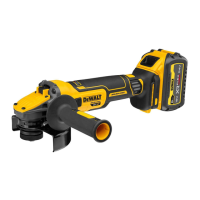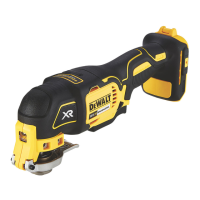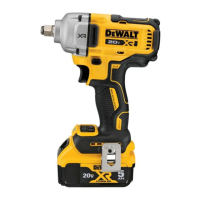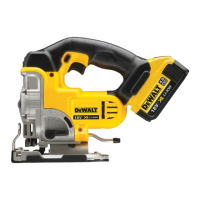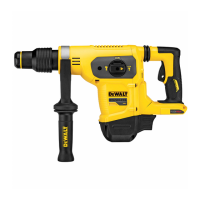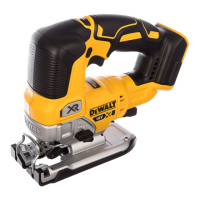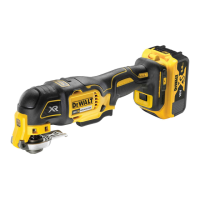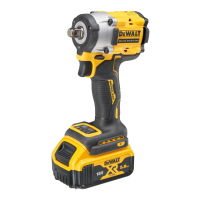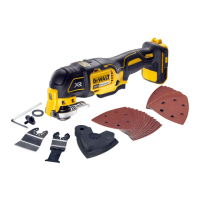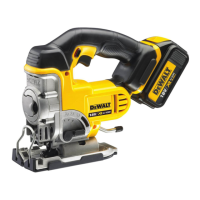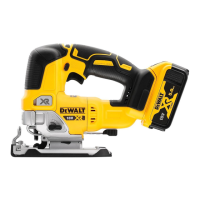49
ENGLISH
Chargers
DeWALT chargers require no adjustment and are designed to be
as easy as possible tooperate.
Electrical Safety
The electric motor has been designed for one voltage only.
Always check that the battery pack voltage corresponds to the
voltage on the rating plate. Also make sure that the voltage of
your charger corresponds to that of yourmains.
i
Your DeWALTcharger is double insulated in
accordance with EN60335; therefore no earth wire
isrequired.
If the supply cord is damaged, it must be replaced only by
DeWALT or an authorised serviceorganisation.
Mains Plug Replacement
(U.K.& Ireland Only)
If a new mains plug needs to be fitted:
• Safely dispose of the oldplug.
• Connect the brown lead to the live terminal in theplug.
• Connect the blue lead to the neutralterminal.
WARNING: No connection is to be made to the
earthterminal.
Follow the fitting instructions supplied with good quality plugs.
Recommended fuse: 3A.
Using an Extension Cable
An extension cord should not be used unless absolutely
necessary. Use an approved extension cable suitable for the
power input of your charger (see Technical Data). The minimum
conductor size is 1mm
2
; the maximum length is30m.
When using a cable reel, always unwind the cablecompletely.
Important Safety Instructions for All BatteryChargers
SAVE THESE INSTRUCTIONS: This manual contains important
safety and operating instructions for compatible battery
chargers (refer to TechnicalData).
• Before using charger, read all instructions and cautionary
markings on charger, battery pack, and product using
batterypack.
WARNING: Shock hazard. Do not allow any liquid to get
inside charger. Electric shock mayresult.
WARNING: We recommend the use of a residual current
device with a residual current rating of 30mA orless.
CAUTION: Burn hazard. To reduce the risk of injury,
charge only DeWALT rechargeable batteries. Other types of
batteries may burst causing personal injury anddamage.
• Impairment ofhearing.
• Risk of personal injury due to flyingparticles.
• Risk of burns due to accessories becoming hot
duringoperation.
• Risk of personal injury due to prolongeduse.
SAVE THESE INSTRUCTIONS
Residual Risks
In spite of the application of the relevant safety regulations
and the implementation of safety devices, certain residual risks
cannot be avoided. These are:
may occur. Investigate and take corrective action to
eliminate the cause of wheelbinding.
d ) Do not restart the cutting operation in the
workpiece. Let the wheel reach full speed and
carefully re‑enter the cut. The wheel may bind, walk up
or kickback if the power tool is restarted in theworkpiece.
e ) Support panels or any oversized workpiece to
minimize the risk of wheel pinching and kickback.
Large workpieces tend to sag under their own weight.
Supports must be placed under the workpiece near the line
of cut and near the edge of the workpiece on both sides of
thewheel.
f ) Use extra caution when making a “pocket cut” into
existing walls or other blind areas. The protruding
wheel may cut gas or water pipes, electrical wiring or
objects that can causekickback.
g ) Do not attempt to do curved cutting.
Overstressing the
wheel increases the loading and susceptibility to twisting or
binding of the wheel in the cut and the possibility of kickback
or wheel breakage, which can lead to seriousinjury.
Additional Safety Instructions for
Sanding Operations
a ) Use proper sized sanding disk paper. Follow
manufacturers recommendations, when selecting
sanding paper. Larger sanding paper extending too far
beyond the sanding pad presents a laceration hazard and
may cause snagging, tearing of the disc orkickback.
Additional Safety Instructions for Wire
Brushing Operations
a ) Be aware that wire bristles are thrown by the brush
even during ordinary operation. Do not overstress
the wires by applying excessive load to the brush. The
wire bristles can easily penetrate light clothing and/orskin.
b ) If the use of a guard is specified for wire brushing,
do not allow any interference of the wire wheel or
brush with the guard. Wire wheel or brush may expand
in diameter due to work and centrifugalforces.
Additional Safety Rules for Grinders
a ) Do not use Type 11(flaring cup) wheels on this tool.
Using inappropriate accessories can result ininjury.
b ) Always use side handle. Tighten the handle securely.
The side handle should always be used to maintain control
of the tool at alltimes.
c ) When using segmented diamond wheels, use
only diamond wheels with a peripheral gap not
greater than 10mm and negative rakeangle.
(refer to Additional Information for Guards and
Accessorieschart).
